Evaluation of the Porosity and Morphology of Microstructured Charcoal
Abstract
:1. Introduction
2. Materials and Methods
2.1. Materials
2.2. Methods
3. Results and Discussion
4. Conclusions
Author Contributions
Funding
Institutional Review Board Statement
Informed Consent Statement
Data Availability Statement
Conflicts of Interest
References
- Sabzehmeidani, M.M.; Mahnaee, S.; Ghaedi, M.; Heidari, H.; Roy, V.A.L. Carbon based materials: A review of adsorbents for inorganic and organic compounds. Mater. Adv. 2021, 2, 598–627. [Google Scholar] [CrossRef]
- Kyriakopoulos, G.L.; Tsimnadis, K.; Sebos, I.; Charabi, Y. Investigating the Effect of Pore Size Distribution on the Sorption Types and the Adsorption-Deformation Characteristics of Porous Continua: The Case of Adsorption on Carbonaceous. Mater. Cryst. 2024, 14, 742. [Google Scholar] [CrossRef]
- Gopinath, K.P.; Vo, D.V.N.; Gnana Prakash, D.; Joseph, A.A.; Viswanathan, S.; Arun, J. Environmental applications of carbon-based materials: A review. Environ. Chem. Lett. 2021, 19, 557–582. [Google Scholar] [CrossRef]
- Scholz, M. How Activated Carbon Can Help You—Processes, Properties and Technological Applications. Technologies 2023, 11, 153. [Google Scholar] [CrossRef]
- Díaz-Terán, J.; Nevaskaia, D.M.; López-Peinado, A.J.; Jerez, A. Porosity and adsorption properties of an activated charcoal. Colloids Surf. A Physicochem. Eng. Asp. 2001, 187–188, 167–175. [Google Scholar] [CrossRef]
- Sharma, G.; Sharma, S.; Kumar, A.; Wei Lai, C.; Naushad, M.; Shenaz; Iqbal, J.; Stadler, F.J. Activated Carbon as Superadsorbent and Sustainable Material for Duverse Applications. Adsorbtion Sci. Technol. 2002, 2002, 4184809. [Google Scholar]
- Inyang, M.; Gao, B.; Zimmerman, A.; Zhang, M.; Chen, H. Synthesis, characterization, and dye sorption ability of carbon nanotube–biochar nanocomposites. Chem. Eng. J. 2014, 236, 39–46. [Google Scholar] [CrossRef]
- Saxena, M.; Sharma, N.; Saxena, R. Highly efficient and rapid removal of a toxic dye: Adsorption kinetics, isotherm, and mechanism studies on functionalized multiwalled carbon nanotubes. Surf. Interfaces 2020, 21, 100639. [Google Scholar] [CrossRef]
- Hoang, A.T.; Nižetić, S.; Cheng, C.K.; Luque, R.; Thomas, S.; Banh, T.L.; Pham, V.V.; Nguyen, X.P. Heavy metal removal by biomass-derived carbon nanotubes as a greener environmental remediation: A comprehensive review. Chemosphere 2022, 287, 131959. [Google Scholar] [CrossRef]
- Li, Z.; Sellaoui, L.; Franco, D.; Netto, M.S.; Georgin, J.; Dotto, G.L.; Bajahzar, A.; Belmabrouk, H.; Bonilla-Petriciolet, A.; Li, Q. Adsorption of hazardous dyes on functionalized multiwalled carbon nanotubes in single and binary systems: Experimental study and physicochemical interpretation of the adsorption mechanism. Chem. Eng. J. 2020, 389, 124467. [Google Scholar] [CrossRef]
- Mpouras, T.; Polydera, A.; Dermatas, D.; Verdone, N.; Vilardi, G. Multi wall carbon nanotubes application for treatment of Cr(VI)-contaminated groundwater; Modeling of batch & column experiments. Chemosphere 2021, 269, 128749. [Google Scholar]
- Jatoi, A.S.; Hashmi, Z.; Usman, T.; Mubarak, N.M.; Mozari, S.A.; Karri, R.R.; Koduru, J.R.; Dehghani, M.H. Role of carbon nanomaterials for wastewater treatment—A brief review. In Water Treatment Using Engineered Carbon Nanotubes 2; Micro and Nano Technologies: Amsterdam, The Netherlands, 2024; pp. 29–62. [Google Scholar]
- Mohammad-Khah, A.; Ansari, R. Activated Charcoal: Preparation, characterization and applications: A review article. Int. J. ChemTech Res. 2009, 1, 859–864. [Google Scholar]
- Abe, I.; Hitorni, M.; Ikuta, N.; Tatsamoto, H.; Kera, Y. Pore structural analysis of charcoals by mercury intrusion porosimetry. Carbon 1996, 34, 1163. [Google Scholar] [CrossRef]
- Costa, L.J.; de Castro, V.R.; Trugilho, P.F.; Lana, A.Q.; Oliveira, A.C.; Lima, M.D.R.; Protasio, T.P.; Carneiro, A.C.O.; de Paula, M.O. Physical–chemical properties and hygroscopicity of Brazilian metallurgical charcoal. Wood Sci. Technol. 2024, 58, 503–532. [Google Scholar] [CrossRef]
- Somerville, M.; Jahanshahi, S. The effect of temperature and compression during pyrolysis on the density of charcoal made from Australian eucalypt wood. Renew. Energy 2015, 80, 471–478. [Google Scholar] [CrossRef]
- Ramos, D.C.; Carneiro, A.C.O.; Tangstad, M.; Saadieh, R.; Pereira, B.L.C. Quality of Wood and Charcoal from Eucalyptus Clones for Metallurgical Use. Floresta E Ambiente Wood Sci. Technol. 2019, 26, e20180435. [Google Scholar] [CrossRef]
- Surup, G.R.; Nielsen, H.K.; Heidelmann, M.; Trubetskaya, A. Characterization and reactivity of charcoal from high temperature pyrolysis (800–1600 °C). Fuel 2019, 235, 1544–1554. [Google Scholar] [CrossRef]
- Dufourny, A.; Van De Steene, L.; Humbert, G.; Guibal, D.; Martin, L.; Blin, J. Influence of pyrolysis conditions and the nature of the wood on the quality of charcoal as a reducing agent. J. Anal. Appl. Pyrolysis 2019, 137, 1–13. [Google Scholar] [CrossRef]
- Hared, I.A.; Dirion, J.-L.; Salvador, S.; Lacroix, M.; Rio, S. Pyrolysis of wood impregnated with phosphoric acid for the production of activated carbon: Kinetics and porosity development studies. J. Anal. Appl. Pyrolysis 2007, 79, 101–105. [Google Scholar] [CrossRef]
- Friesen, W.I.; Mikula, R.J. Mercury porosimetry of coals: Pore volume distribution and compressibility. Fuel 1988, 67, 1516–1520. [Google Scholar] [CrossRef]
- Fraga, M.T.; Flores, B.D.; Flores, I.V.; Osório, E.; Vilela, A.C.F. On the microstructure and CO2 reactivity of tar–impregnated charcoal for cokemaking. Fuel 2024, 359, 130451. [Google Scholar] [CrossRef]
- Kuang, S.; Xu, D.; Chen, W.; Huang, X.; Sun, L.; Cai, X.; Yu, X. In situ construction of bamboo charcoal derived SiOx embedded in hierarchical porous carbon framework as stable anode material for superior lithium storage. Appl. Surf. Sci. 2020, 521, 146497. [Google Scholar] [CrossRef]
- Mariana, M.; Mistar, E.M.; Syabriyana, M.; Zulkipli, A.S.; Aswita, D.; Alfatah, T. Properties and adsorptive performance of candlenut shell and its porous charcoals for aqueous mercury(II) removal. Bioresour. Technol. Rep. 2022, 19, 101182. [Google Scholar] [CrossRef]
- Pastor-Villegas, J.; Meneses Rodríguez, J.M.; Pastor-Valle, J.F.; Rouquerol, J.; Denoyel, R.; García García, M. Adsorption–desorption of water vapour on chars prepared from commercial wood charcoals, in relation to their chemical composition, surface chemistry and pore structure. J. Anal. Appl. Pyrolysis 2010, 88, 124–133. [Google Scholar] [CrossRef]
- Rampe, M.J.; Santos, I.R.S.; Rampe, H.L.; Tiwow, V.A.; Roorano, T.E.A. Study of Pore Length and Chemical Composition of Charcoal that Results from the Pyrolysis of Coconut Shell in Bolaang Mongondow, Sulawesi, Indonesia. Karbala Int. J. Mod. Sci. 2022, 8, 96–104. [Google Scholar] [CrossRef]
- Milani, M.D.Y.; Samarawickrama, D.S.; Dharmasiri, G.P.C.A.; Kattegoda, I.R.M. Study the Structure, Morphology, and Thermal Behavior of Banana Fiber and Its Charcoal Derivative from Selected Banana Varieties. J. Nat. Fibers 2016, 13, 332–342. [Google Scholar] [CrossRef]
- Huang, B.; Chen, X.-R.; Jiang, M.-S.; Tang, X.-P.; Gao, S.-Y. Effect of carbonization temperature on microporous structure of charcoal from Chinese fir wood. Linchan Huaxue Yu Gongye/Chem. Ind. For. Prod. 2006, 26, 70–74. [Google Scholar]
- Atlagic, S.G.; Biessikirski, A.; Kuterasiński, Ł.; Dworzak, M.; Twardosz, M.; Sorogas, N.; Arvanitidis, J. On the Investigation of Microstructured Charcoal as an ANFO Blasting Enhancer. Energies 2020, 13, 4681. [Google Scholar] [CrossRef]
- Biessikirski, A.; Kaczmarczyk, G.P.; Kuterasiński, Ł.; Machowski, G.; Stopkowicz, A.; Ruggiero-Mikołajczyk, M. Analysis of Wall Thickness and Absorption Characteristics of Ammonium Nitrate(V) from Various Sources. Materials 2024, 17, 4618. [Google Scholar] [CrossRef]
- Elsaid, S.M.; Anwar, N.; Roush, M. Pesticides’ low-cost removal from polluted groundwater using charcoal from“Salix mucronata” trees activated by gold nitrate. Water Sci. 2024, 38, 48–64. [Google Scholar] [CrossRef]
- Jjagwe, J.; Olupot, P.W.; Menya, E.; Kalibbala, H.M. Synthesis and application of granular activated carbon from biomass waste materials for water treatment: A review. J. Bioresour. Bioprod. 2021, 6, 292–322. [Google Scholar] [CrossRef]
- Nisgoski, S.; Magalhães, W.L.E.; Batista, F.R.R.; França, R.F.; de Muñiz, G.I.B. Anatomical and energy characteristics of charcoal made from five species. Acta Amaz. 2014, 44, 367–372. [Google Scholar] [CrossRef]
- de Muniz, G.I.B.; Carneiro, M.; Batista, F.R.R.; Nisgoski, S. Wood and charcoal identification of five species from the miscellaneous group known in Brazil as “Angelim” by Near-IR and wood anatomy. Maderas Cienc. Tecnolía 2016, 18, 505–522. [Google Scholar]
- Hudspith, V.A.; Belcher, C.M. Observations of the structural changes that occur during charcoalification: Implications for identifying charcoal in the fossil record. Palaeontology 2017, 60, 503–510. [Google Scholar] [CrossRef]
- Li, G.; Gao, L.; Liu, F.; Qiu, M.; Dong, G. Quantitative studies on charcoalification: Physical and chemical changes of charring wood. Fundam Res. 2024, 4, 113–122. [Google Scholar] [CrossRef]
- Bhatia, S.K. Density functional theory analysis of the influence of pore wall heterogeneity on adsorption in carbons. Langmuir. 2002, 18, 6845–6856. [Google Scholar] [CrossRef]
- Huang, W.; Chen, W.; Fu, L.; Zhang, Y.; Wu, N.; Zhu, J.; Xu, X.; Lyu, A. Effect analysis of pore wall thickness, pore size, and functional group of activated carbon on adsorption behavior based on molecular simulation. Environ. Sci. Pollut. Res. 2021, 28, 59908–59924. [Google Scholar] [CrossRef]
- Biessikirski, A.; Gotovac Atlagić, S.; Pytlik, M.; Kuterasiński, Ł.; Dworzak, M.; Twardosz, M.; Nowak-Senderowska, D.; Napruszewska, B.D. The Influence of Microstructured Charcoal Additive on ANFO’s Properties. Energies 2021, 14, 4354. [Google Scholar] [CrossRef]
- Plötze, M.; Niemz, P. Porosity and pore size distribution of different wood types as determined by mercury intrusion porosimetry. Eur. J. Wood Wood Prod. 2010, 69, 649–657. [Google Scholar] [CrossRef]
- Ma, Y. Multiscale Fractal Characterization of Pore Structure for Coal in Different Rank Using Scanning Electron Microscopy and Mercury Intrusion Porosimetry. Processes 2022, 10, 1577. [Google Scholar] [CrossRef]
- Gao, J.; Li, Z.; Tao, X.; Li, X.; Zhu, K. A comprehensive study of multiscale pore structural characteristics in deep-buried coals of different ranks. Sci. Rep. 2025, 15, 8299. [Google Scholar] [CrossRef]
- Ferro, F.S.; Arroyo, F.N.; Rodrigues, E.F.C.; Fraga, I.F.; Almeida, J.P.B.; Ruthes, H.C.; Aquino, V.B.M.; Morales, E.A.M.; de Moraes, M.H.M.; Lahr, F.A.R.; et al. Investigation of pore size distribution by mercury intrusion porosimetry (MIP) technique applied on different OSB panels. BioResources 2021, 16, 6661–6666. [Google Scholar] [CrossRef]
- Guo, J.; Zhang, X.; Lu, C.; Chai, Z.; Kang, G.; Zhao, G.; Kang, T.; Zhang, S.; Li, H. Characterization of Pore Structures with Mercury Intrusion Porosimetry after Electrochemical Modification: A Case Study of Jincheng Anthracite. ACS Omega 2022, 7, 11148–11157. [Google Scholar] [CrossRef] [PubMed]
- Peng, L.M.; Wang, D.; Fu, F.; Song, B.Q. Analysis of wood pore characteristics with mercury intrusion porosimetry and x-ray micro-computed tomography. Wood Res. 2016, 60, 857–864. [Google Scholar]
- Zhang, B.; Wang, H.; Sun, B.; Ouyang, Z.; Dou, W.; Wang, B.; Lai, P.; Hu, Z.; Luo, B.; Yang, M.; et al. Pore Size Distribution and Fractal Characteristics of Deep Coal in the Daning–Jixian Block on the Eastern Margin of the Ordos Basin. ACS Omega 2024, 30, 32837–32852. [Google Scholar] [CrossRef]
- Rohit Bukka, V.V.; Sarin, P. Effects of Particle Size Reduction on the Pore Structure and Accessibility in Natural Porous Materials. Energy Fuels 2024, 38, 9578–9587. [Google Scholar] [CrossRef]
- Mohalik, N.K.; Mandal, S.; Ray, S.K.; Khan, A.M.; Mishra, D.; Pandey, J.K. TGA/DSC study to characterise and classify coal seams conforming to susceptibility towards spontaneous combustion. Int. J. Min. Sci. Technol. 2022, 32, 75–88. [Google Scholar] [CrossRef]
- Li, Q.; Xu, B.; Chen, K.; Cui, Z.; Liu, Y.; Zhang, L. Experimental and Three-Dimensional Numerical Investigations of Dehydration and Pyrolysis in Wood under Elevated and High Temperatures. Buildings 2024, 14, 1547. [Google Scholar] [CrossRef]
- Muangthong-on, T.; Wannapeera, J.; Ohgaki, H.; Miura, K. TG-DSC Study To Measure Heat of Desorption of Water during the Thermal Drying of Coal and To Examine the Role of Adsorption of Water Vapor for Examining Spontaneous Heating of Coal over 100 °C. Energy Fuels 2017, 31, 10691–10698. [Google Scholar] [CrossRef]
- Liang, S.H.C.; Cameron, L.E. Diferential Scanning Calorimetry (DSC) for the Analysis of Activated Carbon (U); Ottawa Report No. 1098; Defence Research Establishment: Ottawa, ON, Canada, 1991. [Google Scholar]
- Hardy, B.; Borchard, N.; Leifeld, J. Thermal signature and quantification of charcoal in soil by differential scanning calorimetry and BPCA markers. SOIL Discuss. 2022, 8, 451–466. [Google Scholar]
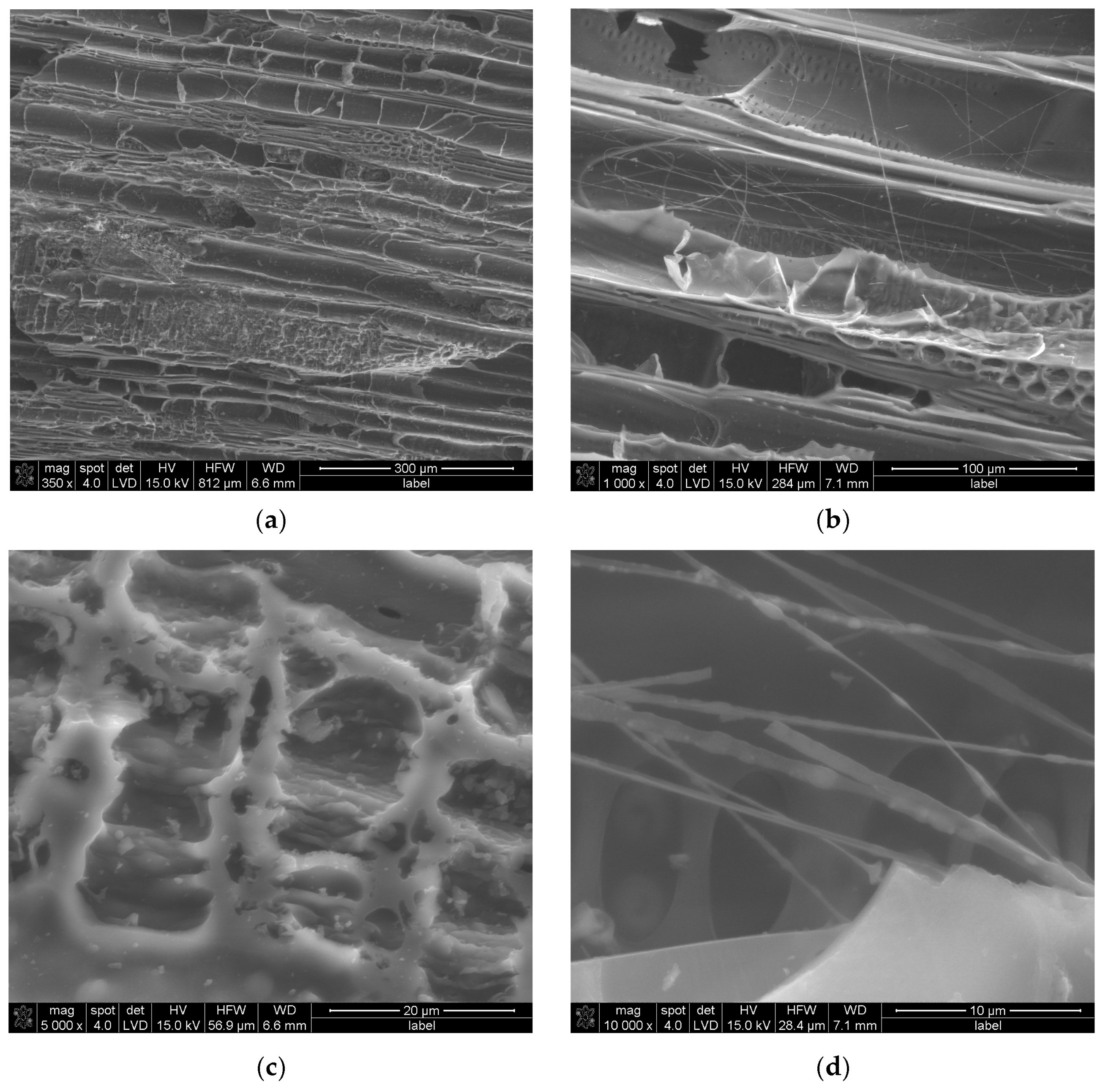
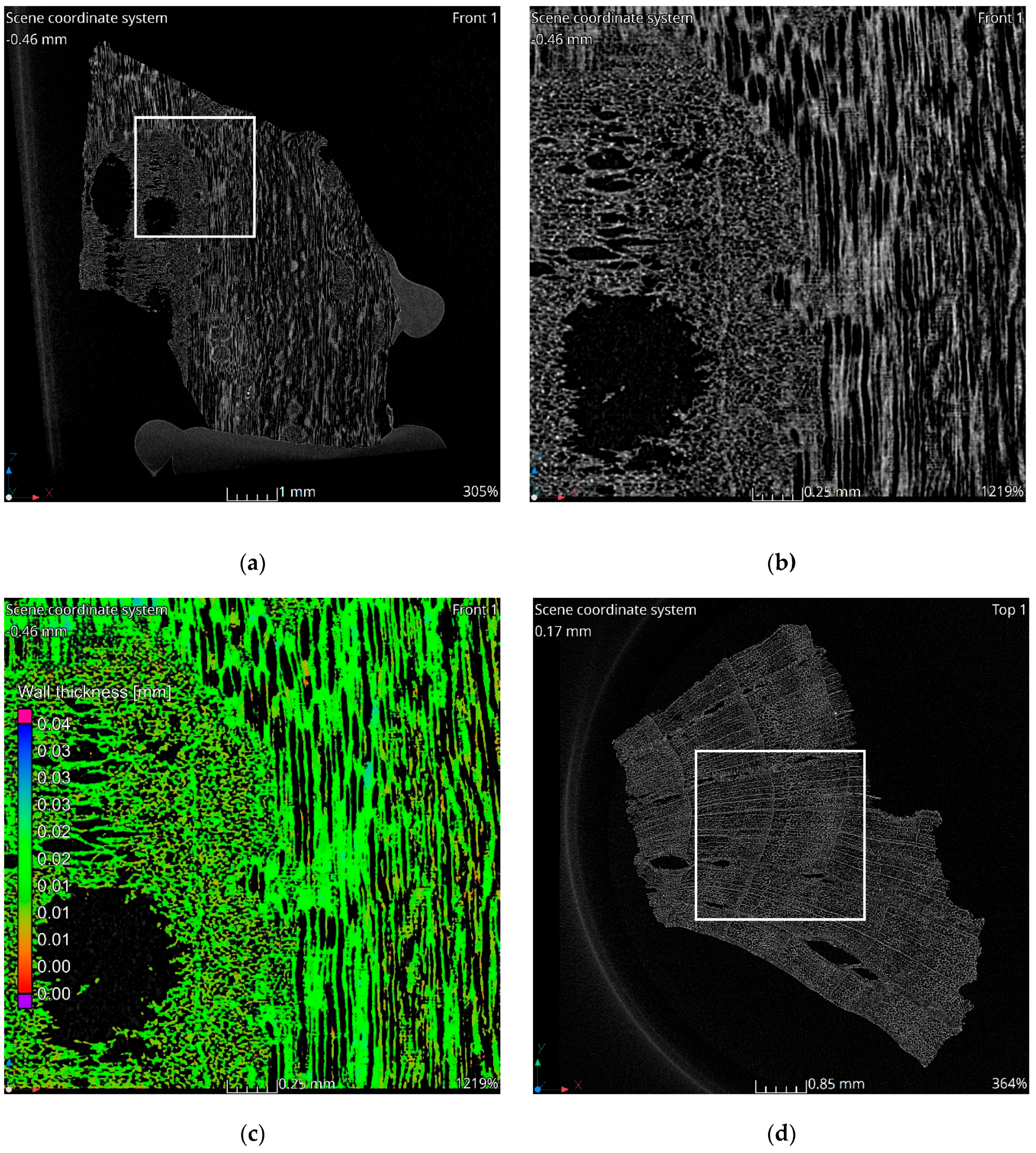
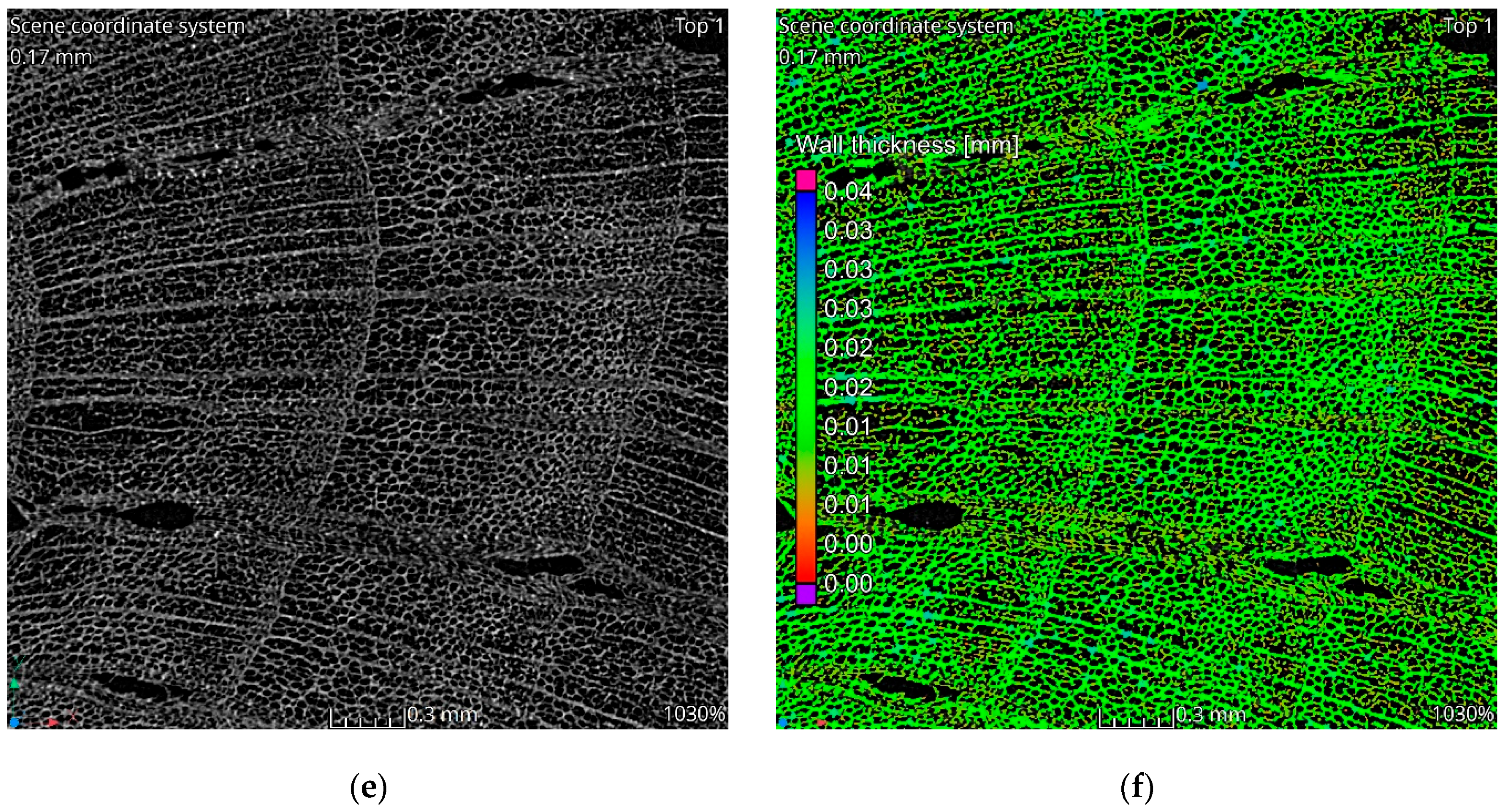
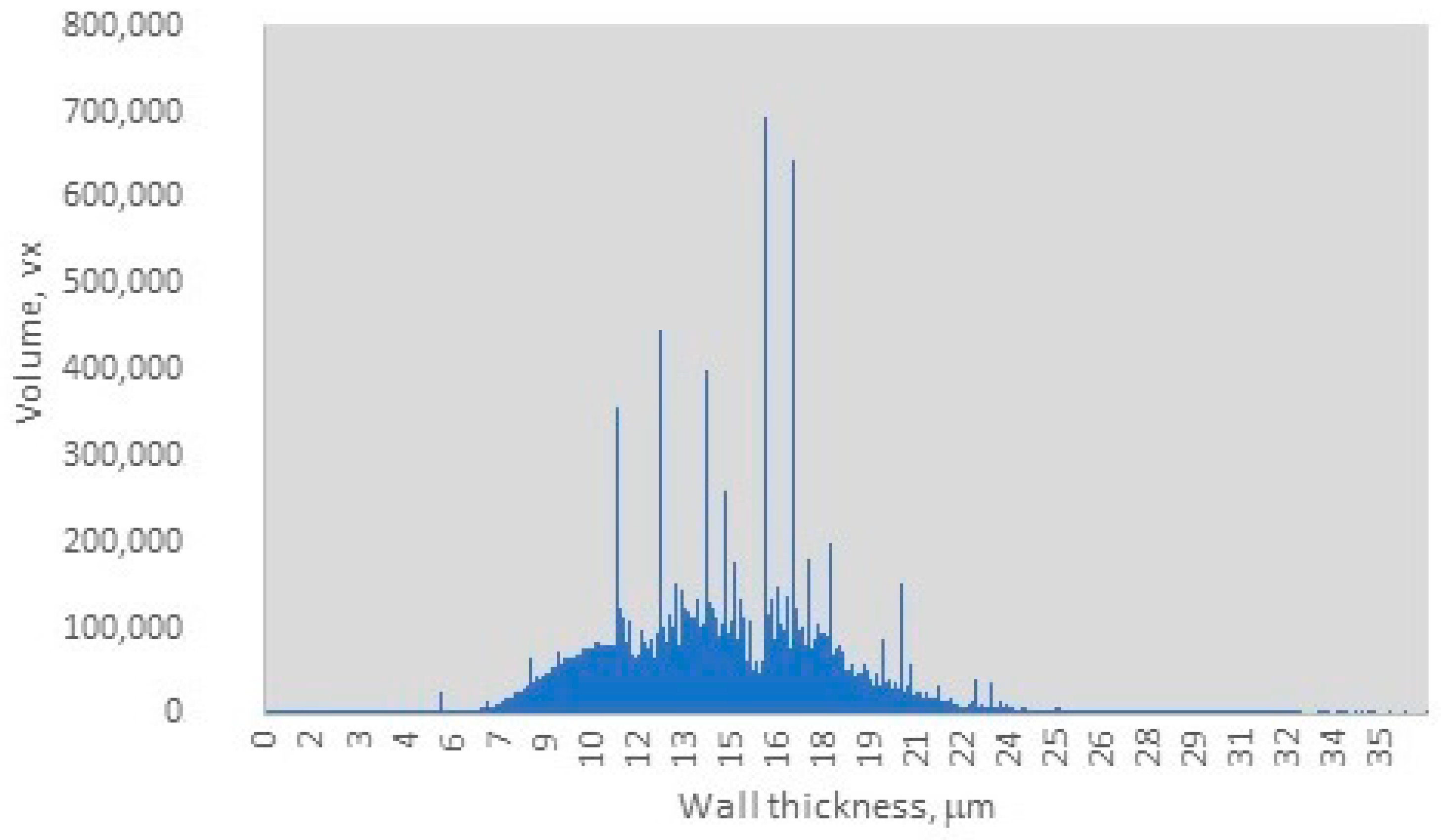
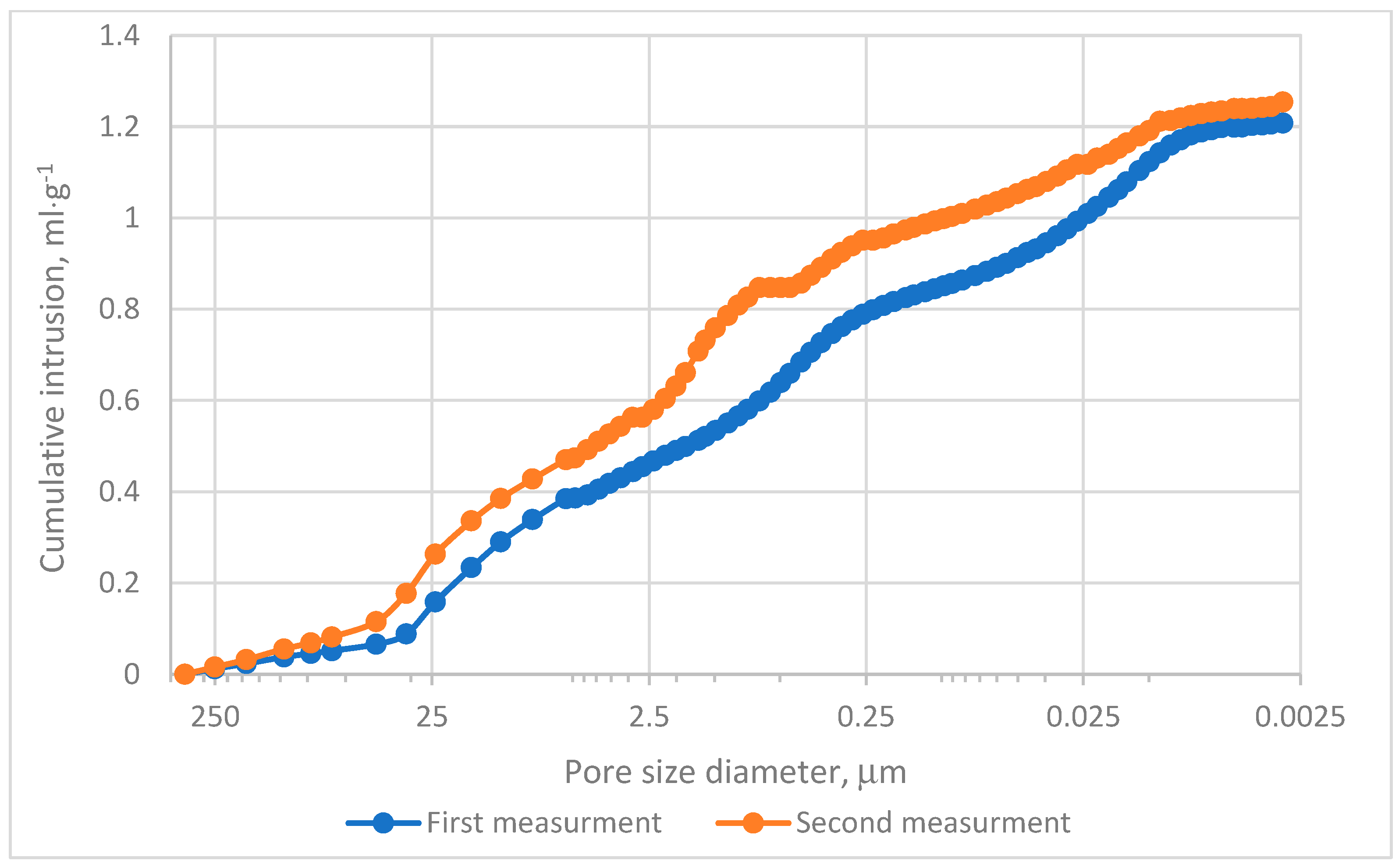

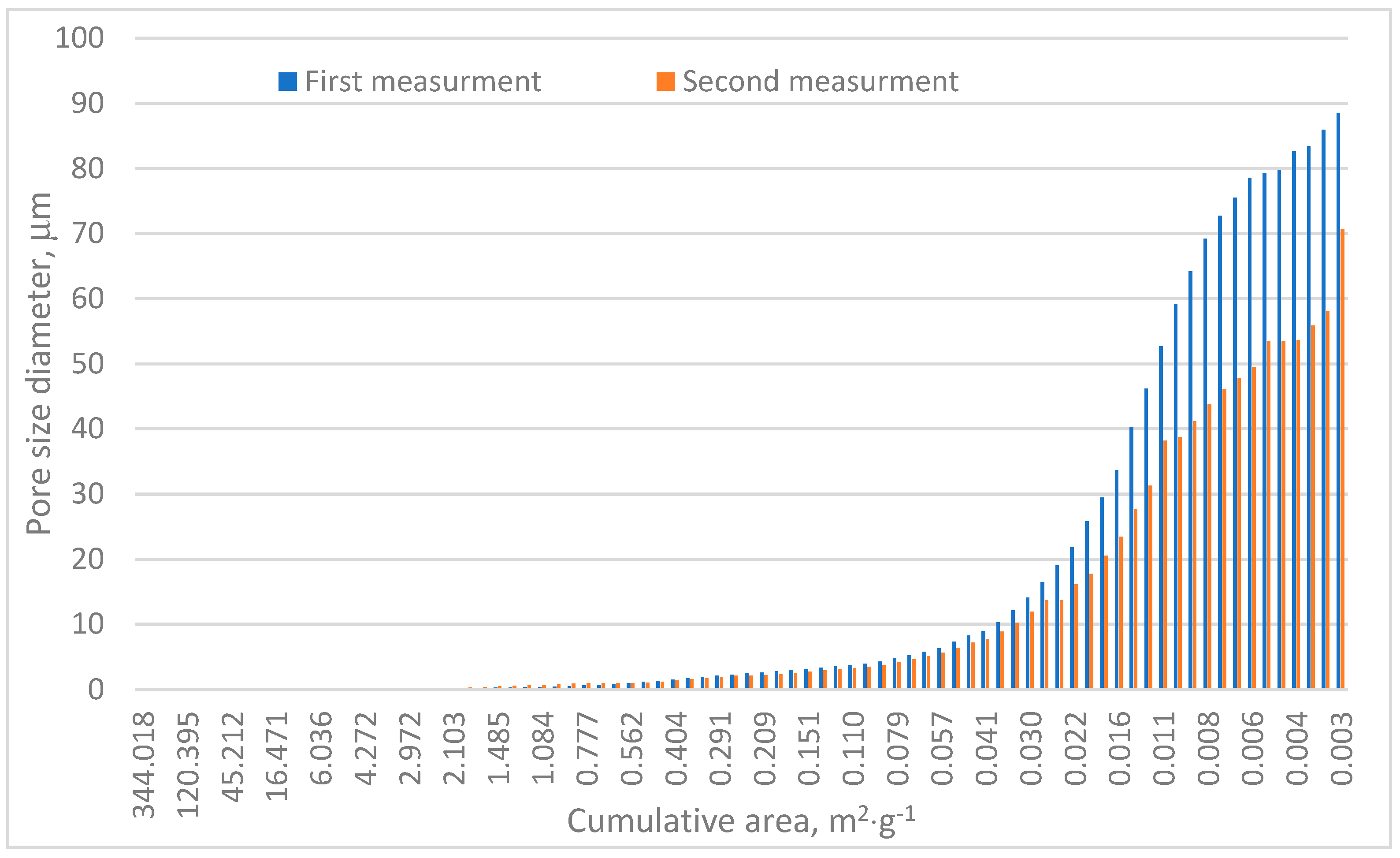

| Parameter | Measurement No. 1 | Measurement No. 2 |
|---|---|---|
| Total intrusion volume, mL·g−1 | 1.2078 | 1.2543 |
| Total pore area, m2·g−1 | 88.496 | 70.662 |
| Average pore diameter, μm | 0.0546 | 0.0710 |
| Porosity, % | 62.4143 | 58.0625 |
Disclaimer/Publisher’s Note: The statements, opinions and data contained in all publications are solely those of the individual author(s) and contributor(s) and not of MDPI and/or the editor(s). MDPI and/or the editor(s) disclaim responsibility for any injury to people or property resulting from any ideas, methods, instructions or products referred to in the content. |
© 2025 by the authors. Licensee MDPI, Basel, Switzerland. This article is an open access article distributed under the terms and conditions of the Creative Commons Attribution (CC BY) license (https://creativecommons.org/licenses/by/4.0/).
Share and Cite
Biessikirski, A.; Dworzak, M.; Kaczmarczyk, G.P.; Machowski, G.; Ziąbka, M.; Kaczmarczyk, A.; Jakóbczyk, J.; Gotovac-Atlagić, S. Evaluation of the Porosity and Morphology of Microstructured Charcoal. Materials 2025, 18, 1730. https://doi.org/10.3390/ma18081730
Biessikirski A, Dworzak M, Kaczmarczyk GP, Machowski G, Ziąbka M, Kaczmarczyk A, Jakóbczyk J, Gotovac-Atlagić S. Evaluation of the Porosity and Morphology of Microstructured Charcoal. Materials. 2025; 18(8):1730. https://doi.org/10.3390/ma18081730
Chicago/Turabian StyleBiessikirski, Andrzej, Michał Dworzak, Grzegorz Piotr Kaczmarczyk, Grzegorz Machowski, Magdalena Ziąbka, Agata Kaczmarczyk, Joanna Jakóbczyk, and Suzana Gotovac-Atlagić. 2025. "Evaluation of the Porosity and Morphology of Microstructured Charcoal" Materials 18, no. 8: 1730. https://doi.org/10.3390/ma18081730
APA StyleBiessikirski, A., Dworzak, M., Kaczmarczyk, G. P., Machowski, G., Ziąbka, M., Kaczmarczyk, A., Jakóbczyk, J., & Gotovac-Atlagić, S. (2025). Evaluation of the Porosity and Morphology of Microstructured Charcoal. Materials, 18(8), 1730. https://doi.org/10.3390/ma18081730







